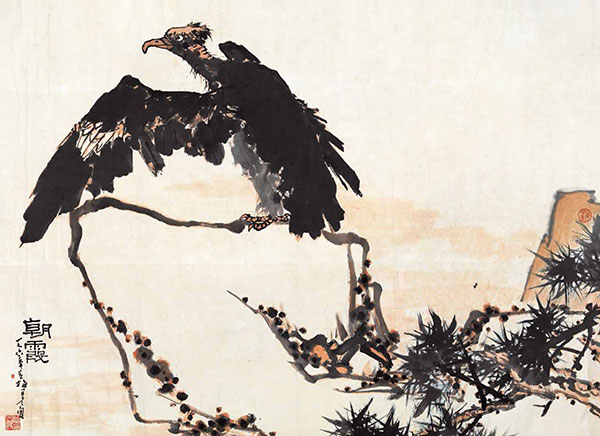- Lot
- Information

Ink painting Morning Glows by Chinese master Pan Tianshou is one of the highlights at China Guardian Auction's autumn sales.
Famed painter and scholar Dong Qichang's landscape, titled Thatched Cottage amid Sparse Forest, will go under the hammer at China Guardian Auctions' autumn sales on Nov 15.
The piece is from a private collector and was listed in the Shiqu Baoji, a collection of imperial artworks of China.
Some of the other items from the same collection have been displayed at Beijing's Palace Museum since September, reigniting people's interest in classical Chinese painting.
The Shiqu Baoji compilation, also known as the Precious Collection of the Stony Moat, includes three editions cataloging non-religious calligraphic works and paintings from the Qing Dynasty (1644-1911) collection.
Many listed works were taken away from the palace during chaotic times and kept in private care. Today, they are highly sought after in the art market and often fetch high prices at auctions.
Dong's piece demonstrates a rich variation of shading and dotting of brushwork. As one lays open this hand scroll, the composition tells the technical and aesthetic accumulations Dong invested in the work. He was considered a painter and an art theorist with profound influence in the late Ming Dynasty (1368-1644).
Collectors in the past used to favor works of court painters, says Guo Tong, general manager of Guardian's Chinese paintings and calligraphy department.
Two painting albums of Jiang Tingxi, a high-ranking Qing official and court painter, sold for more than 21 million yuan ($3.33 million) in 2012.
"Now buyers are shifting their attention to works of independent and scholarly painters," Guo says.
A calligraphic album written in xingshu (cursive) style by Qianlong will be auctioned, too. It was listed as a Shiqu Baoji entry. The emperor completed the leaves at age 61, when he was considered to have achieved mastery in calligraphy.
The two works are among dozens of quality lots to feature in Guardian's "Grand View" night sales of Chinese painting and calligraphy. The sales offer many rarely seen pieces expected to fetch mind-blogging prices. A painting of modern master Pan Tianshou grossed 279 million yuan in a similar sale in May.
Pan's two large paintings, Pine Trees and Morning Glows, will also highlight the upcoming sales. The former shows the master's excellent control of composition, and the latter tells his powerful response to a saying that "classic Chinese paintings were embracing nihilism" in the 1960s.
"Grand View" sales are widely seen as the barometer of the Chinese painting market. The art market has turned sour in the past few months because of the country's economic slowdown. Several collectors and dealers anticipate that upcoming "Grand View" sales, with several celebrity works like Pan's on offer, will boost the art market.
Guo says under the current situation in which collectors are less willing to sell or buy, some auctioneers try to bring people back to the salesroom by selling at rather cheap rates, but she says the strategy wouldn't work for long.
"This is because when the market goes down, buyers become quite picky and prefer saving their money for top-notch artworks, especially the rare ones.
"Categories that interest only a small group of collectors and are priced moderately, such as calligraphic rubbings from tablet inscriptions, are also well received in the market," she says.